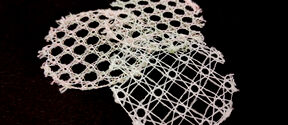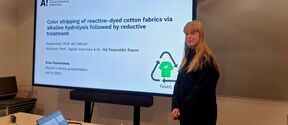Transparent wood-based coating doesn’t fog up
Researchers have developed a way to turn a waste material from wood into a bio-based transparent film that can be used for anti-fogging or anti-reflective coatings on glasses or vehicle windows. In addition to offering an alternative to the toxic synthetic materials currently used, this approach transforms a waste product into a valuable carbon sink.
Lignin is an abundant waste product in paper and pulp production that is very difficult to process, so it’s usually burned to produce heat. Creating lignin nanoparticles to use for anti-fogging coatings isn’t a new idea, but scientists haven’t yet been able to turn them into transparent films.
‘Optical coatings need to be transparent, but so far, even rather thin lignin particle films have been visible. We knew that small particles appear less turbid, so I wanted to see if I could make invisible particle films by pushing the particle size to a minimum,’ says doctoral researcher Alexander Henn, the study’s lead author. The team used acetylated lignin and developed an improved way to esterify it in a reaction that takes just a few minutes and happens at the relatively low temperature of 60 °C.
‘The lignin particles I made from the acetylated lignin had rather surprising properties, which made the rest of this study very interesting. The possibility to make photonic films, for example, came as a total surprise,’ says Henn.
In addition to anti-fogging and anti-reflective coatings, the new approach can also make coloured films from lignin nanoparticles. By controlling the thickness of the coating and using multi-layer films, the team created materials with different structural colours.
‘Sahar Babaeipour’s efforts were key to controlling the particles’ photonic properties,’ says Henn, adding that researchers Paula Nousiainen and Kristoffer Meinander brought expertise in lignin chemistry and photonic phenomena, respectively, helping the team make sense of their results and use them effectively.
According to the team’s feasibility study, the ease of the reaction and its high yield mean that it could profitably be scaled up to industrial levels. ‘Lignin-based products could be commercially valuable and simultaneously act as carbon sinks, helping relieve the current fossil fuel-dependence and reduce carbon dioxide emissions,’ says Professor Monika Österberg. ‘High value-added applications like this are important to drive lignin valorisation and move us away from using lignin only as a fuel.’
Henn notes the study benefited from having perspectives that took it beyond the lab bench. ‘Teamwork was an important part of making this study impactful. We were able to include the techno-economic analysis with the help of Professor Pekka Oinas and doctoral researcher Susanna Forssell,’ he says.
The study was published in Chemical Engineering Journal and was carried out as part of FinnCERES, the Academy of Finland’s flagship centre for materials bioeconomy research.
Alexander Henn
Read more news

Smart textiles are reshaping our understanding of materials – and interspecies communication
The PAST-A-BOT research project, funded by the European Research Council (ERC), is developing soft, intelligent textiles that could one day function as rescue robots, sound-sensing agricultural fabrics, or assistive clothing. At the same time, the project aims to rethink the way we approach materials research.
Master’s student showcases efficient color stripping of cotton fabrics
On December 9, master’s thesis student Elsa Vuorenmaa from the Textile Chemistry Group presented the results of her research on color stripping of reactive-dyed cotton fabrics.
Future makers research batteries, cryptography and plastic recycling
The Technology Industries of Finland Centennial Foundation awarded 3.5 million euros in research funding to eight projects, five from Aalto University.






